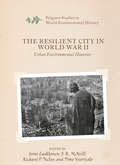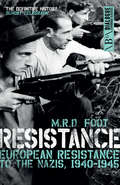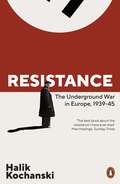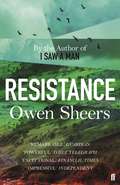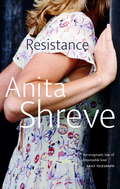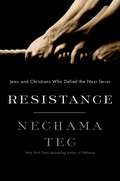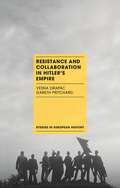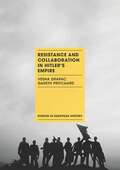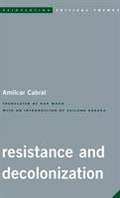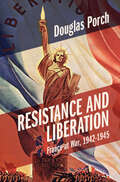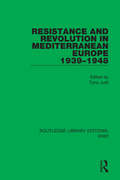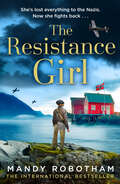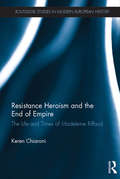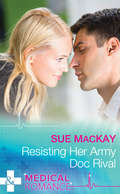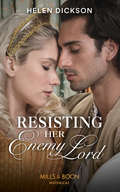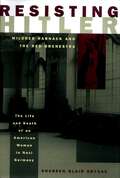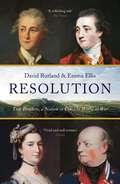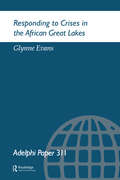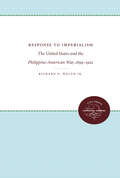- Table View
- List View
Resilience and Military Families: Case Vignettes, Self-Assessment Tools, and Evidence-Based Interventions
by Julie CanfieldThis textbook aims to educate students across all mental health disciplines on the importance of using strengths-based resilience as a tool when working with military families. Organized into three main sections using the military deployment cycle, including the stages of pre-deployment, deployment, and post-deployment, this textbook examines some of the key resiliency skills that operate in military families so that students can understand how many families not only survive, but learn how to thrive, during great challenges. Chapters address the military at home, resilient family systems, the importance of effective communication and social support, the impact of trauma and moral injury, and the transition from military to civilian life following service. Filled with case vignettes, self-assessment tools, and evidence-informed interventions, readers learn multiple ways to measure, assess, and strengthen family resiliency throughout the book. In addition to these skills, specific examples are highlighted that draw lessons from the military community on stress management and posttraumatic growth in the context of family life. The book finishes with an appendix that includes suggestions for therapists on the use of cultural humility to improve treatment.Following two decades of war and a global pandemic, this essential textbook is a crucial read for all mental health professionals training to work with miliary-connected populations and their families. Professionals from disciplines including clinical social work, marriage and family therapy, psychology, healthcare, and theology as well as instructors of courses on military social work, military psychology, and mental health will all find this text an invaluable resource.
The Resilient City in World War II: Urban Environmental Histories (Palgrave Studies in World Environmental History)
by J. R. McNeill Richard P. Tucker Simo Laakkonen Timo VuorisaloThe fate of towns and cities stands at the center of the environmental history of World War II. Broad swaths of cityscapes were destroyed by the bombing of targets such as transport hubs, electrical grids, and industrial districts, and across Europe, Asia, and the Americas, urban environments were transformed by the massive mobilization of human and natural resources to support the conflict. But at the same time, the war saw remarkable resilience among the human and non-human residents of cities. Foregrounding the concept of urban resilience, this collection uncovers the creative survival strategies that city-dwellers of all kinds turned to in the midst of environmental devastation. As the first major study at the intersection of environmental, urban, and military history, The Resilient City in World War II lays the groundwork for an improved understanding of rapid change in urban environments, and how societies may adapt.
Resistance: European Resistance to the Nazis, 1940-1945
by M. R. Foot"If you who read this can say, I am not under fire; I am not under torture; I am not on the run; if I hear a noise at six in the morning, I know it is a neighbour or a milkman, not the secret police; no one in my country is arrested and held without prompt charge and trial... then you owe it, in a larger degree than most historians have so far allowed, to the resistance that occupied Europe put up to Hitler." An instant classic upon its initial publication in 1976, this fluent and persuasive book was the first to analyse the whole field of wartime resistance to the Nazis in Europe, to explain what resisters could and could not do, and to assess whether they achieved their aims. It is a truly epic theme, with its drama of intelligence, deception, escape and subversion. In gathering the threads of this important narrative into the fabric of a single volume, M. R. D. Foot, one of the most distinguished historians of his time, achieved a work of gripping and major significance.
Resistance: The Underground War in Europe, 1939-1945
by Halik Kochanski'The best book about the subject I have ever read' Max Hastings, Sunday Times'A superb, myth-busting survey of the many ways in which the subjugated peoples of Europe tried to fight back' Saul David, Daily TelegraphA sweeping history of occupation and resistance in war-torn Europe, from the acclaimed author of The Eagle UnbowedAcross the whole of Nazi-ruled Europe the experience of occupation was sharply varied. Some countries - such as Denmark - were allowed to run themselves within tight limits. Others - such as France - were constrained not only by military occupation but by open collaboration. In a historical moment when Nazi victory seemed permanent and irreversible, the question 'why resist?' was therefore augmented by 'who was the enemy?'. Resistance is an extraordinarily powerful, humane and haunting account of how and why all across Nazi-occupied Europe some people decided to resist the Third Reich. This could range from open partisan warfare in the occupied Soviet Union to dangerous acts of insurrection in the Netherlands or Norway. Some of these resistance movements were entirely home-grown, others supported by the Allies. Like no other book, Resistance shows the reader just how difficult such actions were. How could small bands of individuals undertake tasks which could lead not just to their own deaths but those of their families and their entire communities? Filled with powerful and often little-known stories, Halik Kochanski's major new book is a fascinating examination of the convoluted challenges faced by those prepared to resist the Germans, ordinary people who carried out exceptional acts of defiance.
Resistance
by Owen Sheers1944. After the fall of Russia and the failed D-Day landings, half of Britain is occupied . . . Young farmer's wife Sarah Lewis wakes to find her husband has disappeared, along with all of the men from her remote Welsh village.A German patrol arrives in the valley, the purpose of their mission a mystery. Sarah begins a faltering acquaintance with the patrol's commanding officer, Albrecht, and it is to her that he reveals the purpose of his mission - to claim an extraordinary medieval art treasure that lies hidden in the valley. But as the pressure of the war beyond presses in on this isolated community, this fragile state of harmony is increasingly threatened.
Resistance: A Novel
by Anita ShreveAs the wife of a Resistance member in German-occupied Belgium, Claire Daussois has grown used to hiding strange men in her attic. By the end of 1943, the tiny room has housed dozens of Allied airmen, soldiers and other refugees, whom Claire nurses and harbours from the perpetual threat of discovery by the Gestapo.The B-17 bomber that crash-lands outside Claire's village of Delahaut contains the man who will be both the last and the most significant of the attic's residents: US Air Force pilot Ted Brice. Ted is found severely wounded and semi-conscious by ten-year-old Jean Benoit minutes before the Germans begin their search for survivors. Knowing of Claire's connections with the Resistance, and desperate to atone for his father's shameful collaboration, Jean realises that Claire is the pilot's only hope of survival.The month that follows will stay with them both for the rest of their lives. A few weeks only, a handful of days, it is a period in which the war recedes in the face of more powerful forces - before imposing itself once more with shocking suddenness.
Resistance: Jews and Christians Who Defied the Nazi Terror
by Nechama TecNechama Tec's Defiance, an account of a Jewish partisan unit that fought the Nazis in the Polish forests during World War II, was turned into a major feature film. Yet despite the attention this film brought to the topic of Jewish resistance, Tec, who speaks widely about the Holocaust and the experience of Jews in wartime Poland, still ran into the same question again and again: Why didn't Jews fight back? To Tec, this question suggested that Jews were somehow complicit in their own extermination. Despite works by Tec and others, the stereotype of Jewish passivity in the Holocaust persists. In Resistance, Tec draws on first-hand accounts, interviews, and other sources to reveal the full range of tactics employed to resist the Nazi regime in Poland. She compares Jewish and non-Jewish groups, showing that they faced vastly different conditions. The Jewish resistance had its own particular aims, especially the recovery of dignity and the salvation of lives. Tec explores the conditions necessary for resistance, including favorable topography, a supply of arms, and effective leadership, and dedicates the majority of the book to the stories of those who stood up and fought back in any way that they could. Emphasizing the centrality of cooperation to the Jewish and Polish resistance movements of World War II, Tec argues that resistance is more than not submitting--that it requires taking action, and demands cooperation with others. Whereas resilience is individual in orientation, Tec writes, resistance assumes others. Within this context, Tec explores life in the ghettoes, the organizations that arose within them, and the famous uprising in Warsaw that began on January 18, 1943. She tells of those who escaped to hide and fight as partisans in the forests, and considers the crucial role played by women who acted as couriers, carrying messages and supplies between the ghetto and the outside world. Tec also discusses resistance in concentration camps, vividly recounting the Auschwitz-Birkenau camp uprising on October 7, 1944. The refusal of the rebel leaders to give information under unspeakable torture, Tec displays, was just one more of the many forms resistance took. Resistance is a rich book that forever shatters the myth of Jewish passivity in the face of annihilation.
Resistance: Jews and Christians Who Defied the Nazi Terror
by Nechama TecNechama Tec's Defiance, an account of a Jewish partisan unit that fought the Nazis in the Polish forests during World War II, was turned into a major feature film. Yet despite the attention this film brought to the topic of Jewish resistance, Tec, who speaks widely about the Holocaust and the experience of Jews in wartime Poland, still ran into the same question again and again: Why didn't Jews fight back? To Tec, this question suggested that Jews were somehow complicit in their own extermination. Despite works by Tec and others, the stereotype of Jewish passivity in the Holocaust persists. In Resistance, Tec draws on first-hand accounts, interviews, and other sources to reveal the full range of tactics employed to resist the Nazi regime in Poland. She compares Jewish and non-Jewish groups, showing that they faced vastly different conditions. The Jewish resistance had its own particular aims, especially the recovery of dignity and the salvation of lives. Tec explores the conditions necessary for resistance, including favorable topography, a supply of arms, and effective leadership, and dedicates the majority of the book to the stories of those who stood up and fought back in any way that they could. Emphasizing the centrality of cooperation to the Jewish and Polish resistance movements of World War II, Tec argues that resistance is more than not submitting--that it requires taking action, and demands cooperation with others. Whereas resilience is individual in orientation, Tec writes, resistance assumes others. Within this context, Tec explores life in the ghettoes, the organizations that arose within them, and the famous uprising in Warsaw that began on January 18, 1943. She tells of those who escaped to hide and fight as partisans in the forests, and considers the crucial role played by women who acted as couriers, carrying messages and supplies between the ghetto and the outside world. Tec also discusses resistance in concentration camps, vividly recounting the Auschwitz-Birkenau camp uprising on October 7, 1944. The refusal of the rebel leaders to give information under unspeakable torture, Tec displays, was just one more of the many forms resistance took. Resistance is a rich book that forever shatters the myth of Jewish passivity in the face of annihilation.
Resistance and Collaboration in Hitler's Empire (Studies in European History)
by Vesna Drapac Gareth PritchardThis new study provides a concise, accessible introduction to occupied Europe. It gives a clear overview of the history and historiography of resistance and collaboration. It explores how these terms cannot be examined separately, but are always entangled.Covering Europe from east to west, this book aims to explore the evolution of scholarly approaches to resistance and collaboration. Not limiting itself to any one area, it looks at armed struggle, daily life, complicity and rescue, the Catholic Church, and official and public memory since the end of the war.
Resistance and Collaboration in Hitler's Empire (Studies in European History)
by Gareth Pritchard Vesna DrapacThis new study provides a concise, accessible introduction to occupied Europe. It gives a clear overview of the history and historiography of resistance and collaboration. It explores how these terms cannot be examined separately, but are always entangled. Covering Europe from east to west, this book aims to explore the evolution of scholarly approaches to resistance and collaboration. Not limiting itself to any one area, it looks at armed struggle, daily life, complicity and rescue, the Catholic Church, and official and public memory since the end of the war.
Resistance and Decolonization (PDF)
by Cabral Wood Rabaka Amilcar Cabral Reiland Rabaka Daniel A. WoodHow can a people overthrow 500 years of colonial oppression? What can be done to decolonize mentalities, economic structures, and political institutions? In this book, which includes the first translation of the text ‘Analysis of a Few Types of Resistance’ as well as ‘The Role of Culture in the Struggle for Independence,’ the African revolutionary Amílcar Cabral explores these and other questions. These texts demonstrate his frank and insightful directives to his comrades in Guinea-Bissau and Cape Verde’s party for independence, as well as reflections on culture and combat written the year prior to his assassination by the Portuguese secret police. As one of the most important and profound African revolutionary leaders in the 20th century, and justly compared in importance to Frantz Fanon, Cabral’s thoughts and instructions as articulated here help us to rethink important issues concerning nationalism, culture, vanguardism, revolution, liberation, colonialism, race, and history. The volume also includes two introductory essays: the first introduces Cabral’s work within the context of Africana critical theory, and the second situates these texts in the context their historical-political context and analyzes their relevance for contemporary anti-imperialism.
Resistance and Liberation: France at War, 1942-1945 (Armies of the Second World War)
by null Douglas PorchIn Resistance and Liberation, Douglas Porch continues his epic history of France at war. Emerging from the debâcle of 1940, France faced the quandary of how to rebuild military power, protect the empire, and resuscitate its global influence. While Charles de Gaulle rejected the armistice and launched his offshore crusade to reclaim French honor within the Allied camp, defeatists at Vichy embraced cooperation with the victorious Axis. The book charts the emerging dynamics of la France libre and the Alliance, Vichy collaboration, and the swelling resistance to the Axis occupation. From the campaigns in Tunisia and Italy to Liberation, Douglas Porch traces how de Gaulle sought to forge a French army and prevent civil war. He captures the experiences of ordinary French men and women caught up in war and defeat, the choices they made, the trials they endured, and how this has shaped France's memory of those traumatic years.
Resistance and Revolution in Mediterranean Europe 1939–1948 (Routledge Library Editions: WW2 #27)
by Tony JudtThis book, first published in 1989, is the first general study of Communism in Mediterranean Europe during and immediately after the war. It sheds light on the origins of Europe’s Cold War East-West divide and probes the common and conflicting interests of the Soviet Union with the separate national and Communist resistance movements. It explores controversial issues including Stalin’s intentions in post-war diplomacy, Communist attitudes to Nazi collaboration in France, and the origins of the Cold War. The decade following the outbreak of the war saw the transformation of society through armed conflict, national resistance and political revolution. The relationship between resistance to Fascism and occupation, on the one hand, and profound social and political changes on the other, was especially marked in southern Europe. In France and Italy, Communist parties emerged as prominent participants in post-war governments; in Yugoslavia the Communist partisans seized full power and effected a social revolution; while a similar attempt in Greece led to a long and bitter civil war.
Resistance and Revolution in Mediterranean Europe 1939–1948 (Routledge Library Editions: WW2 #27)
by Tony JudtThis book, first published in 1989, is the first general study of Communism in Mediterranean Europe during and immediately after the war. It sheds light on the origins of Europe’s Cold War East-West divide and probes the common and conflicting interests of the Soviet Union with the separate national and Communist resistance movements. It explores controversial issues including Stalin’s intentions in post-war diplomacy, Communist attitudes to Nazi collaboration in France, and the origins of the Cold War. The decade following the outbreak of the war saw the transformation of society through armed conflict, national resistance and political revolution. The relationship between resistance to Fascism and occupation, on the one hand, and profound social and political changes on the other, was especially marked in southern Europe. In France and Italy, Communist parties emerged as prominent participants in post-war governments; in Yugoslavia the Communist partisans seized full power and effected a social revolution; while a similar attempt in Greece led to a long and bitter civil war.
The Resistance Girl
by Mandy RobothamNorway, 1942: She has lost everything to the Nazis. But now she fights back…
Resistance Heroism and the End of Empire: The Life and Times of Madeleine Riffaud (Routledge Studies in Modern European History)
by Keren ChiaroniThis book introduces an English-speaking public to the life of Madeleine Riffaud – one of the last living leaders of the French Resistance. It considers the nature of the rebel hero in France’s founding historical narratives (revolution, insurrection, resistance) while asking what contributions such a hero might make to debates on national identity today. Through a series of narrative close-ups, the book offers perspectives on major chapters in nineteenth- and twentieth-century French history through the eyes of activists who experienced them: the Revolution of July 1830 and the 1851 insurrection against Napoleon, as experienced by Riffaud’s ancestor Edme Liron, and the French Resistance, the Vietnam War and French–Algerian conflict as experienced by Riffaud herself. The book aims to explore the kinds of choices individuals face when their beliefs set them at odds with the state, and to suggest that there is a place for individual action in a global arena where state boundaries are becoming increasingly less relevant.
Resistance Heroism and the End of Empire: The Life and Times of Madeleine Riffaud (Routledge Studies in Modern European History)
by Keren ChiaroniThis book introduces an English-speaking public to the life of Madeleine Riffaud – one of the last living leaders of the French Resistance. It considers the nature of the rebel hero in France’s founding historical narratives (revolution, insurrection, resistance) while asking what contributions such a hero might make to debates on national identity today. Through a series of narrative close-ups, the book offers perspectives on major chapters in nineteenth- and twentieth-century French history through the eyes of activists who experienced them: the Revolution of July 1830 and the 1851 insurrection against Napoleon, as experienced by Riffaud’s ancestor Edme Liron, and the French Resistance, the Vietnam War and French–Algerian conflict as experienced by Riffaud herself. The book aims to explore the kinds of choices individuals face when their beliefs set them at odds with the state, and to suggest that there is a place for individual action in a global arena where state boundaries are becoming increasingly less relevant.
Resisting Her Army Doc Rival: Resisting Her Army Doc Rival / A Month To Marry The Midwife (Mills And Boon Medical Ser.)
by Sue MacKayFlirting with danger!
Resisting Her Enemy Lord (Mills And Boon Historical Ser.)
by Helen DicksonA tumultuous journey A tale of war, betrayal and passion…
Resisting Hitler: Mildred Harnack and the Red Orchestra
by Shareen Blair BrysacThis gripping and heartbreaking narrative is the first full account of an American woman who gave her life in the struggle against the Nazi regime. As members of a key resistance group, Mildred Harnack and her husband, Arvid, assisted in the escape of German Jews and political dissidents, and for years provided vital economic and military intelligence to both Washington and Moscow. But in 1942, following a Soviet blunder, the Gestapo arrested, tortured, and tried some four score members of the Harnacks' group, which the Nazis dubbed the Red Orchestra. Mildred Fish-Harnack was guillotined in Berlin on February 16, 1943, on the personal instruction of Adolf Hitler--she was the only American woman to be executed as an underground conspirator during World War II. Yet as the war ended and the Cold War began, her courage, idealism, and self-sacrifice went largely unacknowledged in America and the democratic West, and were distorted and sanitized in the Communist East. Only now, with the opening of long-sealed archives from Germany, the KGB, the CIA, and the FBI, can the full story be told. In this superbly told life of an unjustly forgotten woman, Shareen Blair Brysac depicts the human side of a controversial resistance group that for too long has been portrayed as merely a Soviet espionage network.
Resisting Hitler: Mildred Harnack and the Red Orchestra
by Shareen Blair BrysacThis gripping and heartbreaking narrative is the first full account of an American woman who gave her life in the struggle against the Nazi regime. As members of a key resistance group, Mildred Harnack and her husband, Arvid, assisted in the escape of German Jews and political dissidents, and for years provided vital economic and military intelligence to both Washington and Moscow. But in 1942, following a Soviet blunder, the Gestapo arrested, tortured, and tried some four score members of the Harnacks' group, which the Nazis dubbed the Red Orchestra. Mildred Fish-Harnack was guillotined in Berlin on February 16, 1943, on the personal instruction of Adolf Hitler--she was the only American woman to be executed as an underground conspirator during World War II. Yet as the war ended and the Cold War began, her courage, idealism, and self-sacrifice went largely unacknowledged in America and the democratic West, and were distorted and sanitized in the Communist East. Only now, with the opening of long-sealed archives from Germany, the KGB, the CIA, and the FBI, can the full story be told. In this superbly told life of an unjustly forgotten woman, Shareen Blair Brysac depicts the human side of a controversial resistance group that for too long has been portrayed as merely a Soviet espionage network.
Resolution: Two Brothers. A Nation in Crisis. A World at War
by David Rutland Emma EllisJohn Manners, Marquis of Granby, famously led a cavalry charge during the Seven Years War in 1760, losing both hat and wig. A commander of skill and courage, he was cherished by his men and lauded by the British public as an authentic military hero. Granby predeceased his father, the 3rd Duke of Rutland, and never inherited his title, but left two sons whose contrasting fortunes and tragically short lives are the subject of this meticulously researched and richly illustrated book. Charles became 4th Duke in 1779, sought reconciliation with the American colonies and was Viceroy of Ireland; Robert embarked on a naval career, became flag captain of the Resolution and died of injuries sustained at the Battle of the Saintes. Based upon the detailed archives held at Belvoir Castle, Resolution is both an enthralling saga of two generations of the Manners family and a finely delineated portrait of aristocratic, political and naval life in mid-Georgian England.
Responding to Crises in the African Great Lakes (Adelphi series)
by G. EvansExamines the international responses to the ethnic conflicts in Burundi and Rwanda from 1993-1997 and their overspill into Zaire. Concludes that the external reaction was impotent and incoherent, and urges a number of changes in response by the international community.
Responding to Crises in the African Great Lakes (Adelphi series)
by G. EvansExamines the international responses to the ethnic conflicts in Burundi and Rwanda from 1993-1997 and their overspill into Zaire. Concludes that the external reaction was impotent and incoherent, and urges a number of changes in response by the international community.
Response to Imperialism: The United States and the Philippine-American War, 1899-1902
by Richard E. WelchThis is a study of the impact of the Filipino Insurrection on American society and politics. It is the first work to evaluate in detail the response of public opinion to that war and to analyze official and popular response in the light of the values and anxieties of the American people. Although that response suggests parallels with American intervention in Vietnam, it must be evaluated within the context of the diplomatic ambitions of the United States during 1899-1902.Originally published 1979.A UNC Press Enduring Edition -- UNC Press Enduring Editions use the latest in digital technology to make available again books from our distinguished backlist that were previously out of print. These editions are published unaltered from the original, and are presented in affordable paperback formats, bringing readers both historical and cultural value.

